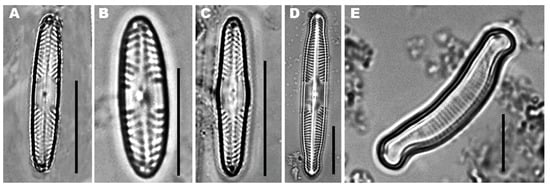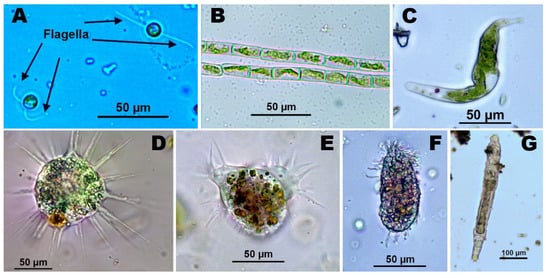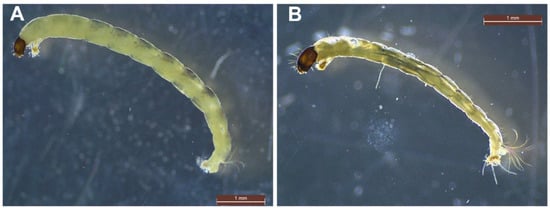You're using an outdated browser. Please upgrade to a modern browser for the best experience.
Please note this is an old version of this entry, which may differ significantly from the current revision.
Subjects:
Environmental Sciences
Acid Mine Drainage (AMD) results from sulfide oxidation, which incorporates hydrogen ions, sulfate, and metals/metalloids into the aquatic environment, allowing fixation, bioaccumulation and biomagnification of pollutants in the aquatic food chain. Acidic leachates from waste rock dams from pyritic and (to a lesser extent) coal mining are the main foci of Acid Mine Drainage (AMD) production.
- : AMD (Acid Mine Drainage)
- metal mining
1. Diatoms
The diatoms are one of the most effective ecological indicators [14,15,16,17,20,31,43] in AMD-contaminated environments, due to their ubiquity in aquatic habitats [44] and high effectiveness for assessing aquatic health [45]. Thus, they are good indicators of pH changes and very abundant in environments impacted by low pH [46]. Diatoms respond to chemical stress at community and individual levels. At a community level, the highest metal concentrations (i.e., Fe: 6 g/L, Zn 1.7 g/L, Cu 347 mg/L, Cd 3.5 mg/L, Ni 3 mg/L, Mn 0.3 mg/L) and low pH (i.e., 2.0-4.5) result in low diatom diversity (Shannon–Winer diversity index < 2.2 on a 5-point scale) [14,15,16], and the species change to more acidophilic or acidobiontic varieties better-prepared to endure these harsh conditions. This decrease in species richness has been observed in many works [13,15,16,20,31,43,47,48], and is more prominent for diatoms than for macroinvertebrates [23].
The dominant and typical species in acidic waters are Pinnularia acoricola, Pinnularia acidophila, Pinnularia aljustrelica, Eunotia exigua (Figure 1) and Nitzschia hantzschiana [13,14,15,31]. The three Pinnularia species found in the impacted sites; P. aljustrelica is the most abundant due to its capacity to survive a very low pH, i.e., 1.9–4.2 [15,49]. Achnanthidium minutissimum is a difficult species, able to tolerate different environmental conditions and usually the only Achnanthidium species reported in AMD polluted streams [50], being abundant in a wide variety of habitats and environmental conditions [51]. However, A. minutissimum can also appear in unimpacted sites, being the dominant species in less-impacted sites [14]. It is considered to generally be the first taxon to colonize different habitats (e.g., rocks, sediments) [52], and has the ability to invade open areas following changes in environmental conditions [53].

Figure 1. (A) Pinnularia acidophila, (B) Pinnularia acoricola, (C) Pinnularia aljustrelica, (D) Pinnularia subcapitata and (E) Eunotia exigua.
In the Lousal and Aljustrel mining areas located in the Portuguese part of the IPB, the species found (in descending order of dominance) include Brachysira vitrea, Eunotia exigua and Pinnularia c.f. acidophila (Figure 1). In the Aljustrel mining area, with sulfated high to extreme metal/metalloid concentrations and low pH waters, P. aljustrelica, E. exigua (Figure 1) and Nitzschia aff. hantzschiana are the dominant species [15]. However, E. exigua is an acidobiontic taxon, and is the most widespread species in AMD-contaminated streams such as the Río Tinto [16,31,59,60,61] and the Aljustrel streams [14,15,17,55] (Table 1).
Table 1. Diatom species with pH and metal concentrations (mg/L), pH tolerance range and optimum pH.
| Species Name | pH Tolerance Range | Optimum pH | Metal Concentrations |
|---|---|---|---|
| Pinnularia aljustrelica | 2.0–5.0 | 2.0–3.0 | Fe 1300 to 6000 Cu 230–350 Zn 118–170 |
| Pinnularia acidophila | 2.0–4.5 | 2.0–2.2 | |
| Pinnularia acoricola | 2.0–6.0 | 2.0–3.0 | |
| Nitzschia thermalis | 2.0–7.0 | 3.0 | |
| Nitzschia hantzschiana | 2.0–6.8 | 2.0–2.2 | |
| Eunotia exigua | 3.0–5.0 | 3.0 | Similar metal concentrations as above, but species valves are morphologically affected by metals (teratologies) |
| Brachysira vitrea | 4.5–7.5 | 4.8 | Fe 1100 Zn 0.30 Cu 0.64 |
Metals lower biodiversity in several important ways. Diatoms have developed mechanisms such as biotransformation, biomineralization, bioaccumulation and biosorption to cope with heavy metal toxicity [62]; nevertheless, pollution-tolerant and pollution-sensitive diatoms have different responses to metal pollution [63]. When exposed to metals, community size can be impaired through reduction of cell number, selection for smaller species, and decrease in cell size within a given species [17,64,65,66]; diatom growth can be delayed or inhibited, therefore reducing diatom biomass [67] and decreasing the rates of survival and growth. Diatoms are able to sequestrate large quantities of metals from waters [68]. The most common taxa presenting abnormal valves due to metals/pH or metal-pH combination are Fragilaria capucina [69], Fragilaria rumpens and A. minutissimum [69] and Eunotia exigua [15].
Thus, the observed differences in diatom community structure result from the combined action of low pH and highly soluble heavy metals [54,70]. Diatoms can also be susceptible at the individual level showing changes in frustule morphology [17]. The resistance of A. minutissimum to metals is still under discussion, with contradictory results in the literature. It is usually considered an indicator of metal pollution [71], although it could also indicate good general water quality [72].
2. Unicellular and Filamentous Green Algae
Although AMD environments are not appetizing to many species, some genera of unicellular and filamentous green algae can adapt and survive; among these are species from the unicellular genera Chlamydomonas, Chlorella, Cyanidium, Dunaliella, Euglena [73,74] and from the filamentous genera Klesormidium, Microspora, Mougeotia, Ulothrix, Stigeoclomium, Zygnema and Microthammion. The genera Mougeotia, Ulothrix, Chlamydomonas, Chara and Nitella are typical of these environments; however, they may not be as abundant as diatoms [75,76,77].
Cyanidium is a red algae genus, or rhodophite. It has been observed at pH 1.2–1.8 in waters close to the Rio Tinto mines. Dunaliella, Chlamydomonas and Chlorella are unicellular green algae from the Chlorophyceae family. Both Chlamydomonas and Dunaliella may be motile, with the presence of flagella. Curiously, Dunaliella has no cell wall. Chlamydomonas acidophila is the most abundant species in acid waters, showing a high tolerance to copper and other heavy metals [78,79] Euglena mutabilis is abundant in shallow waters and easily forms large tufts that can look like filamentous algae. Oxygen bubbles are frequently observed in some places where Euglena thrives. All microalgae contribute to enhanced oxygen production (up to 200% saturation) and organic carbon, which reduces the oligotrophic conditions of AMD-polluted waters and increases the oxidative activity of aerobic chemoautolithotrophic bacteria and heterotrophic bacteria [80].
The acidophilic species of the Mougeotia genus can survive in the AMD environment, in waters with a pH of 2.9–4.1 [18]. The abundance and distribution of Klebsormidium sp. in AMD affected waters makes this species a good ecological indicator of this type of contamination, and Klebsormidium-dominated algal mats are particularly good indicators of high iron concentrations in water [81]. Additionally, Mougeotia, can be abundant in AMD streams [19,81], possibly because of strong competition for low DIC (dissolved inorganic carbon) in acidic environments [82]. The genus Klebsormidium is known to be metal resistant, and is been related with metal-rich polluted waters. K. subtile, K. rivulare, K. flaccidium and K. acidophilum are other species related with AMD-contaminated environments [19,51,77]. Chlamydomonas sp. shows tolerance in a wide range of physical and chemical conditions in a lake contaminated by AMD, being consistently present [83].
The Microspora genus is very abundant in mines with high levels of metal pollution, and is considered by [84] as a good bioindicator. The Ulothrix genus, on the other hand, is predominant in biofilms from AMD-contaminated sites, having a great capacity to recover Cu and As.
Several of the microorganisms described above are represented in Figure 2.

Figure 2. (A) Unicellular algae (Chlamydomonas acidophila), (B) Filamentous algae (Klebsormidium sp.), (C) Euglena mutabilis, (D) Protozoo Heliozoa, (E) Protozoo Ciliata, (F) Amoeba, (G) Rotífer.
3. Protozoa, Fungi and Yeasts in AMD-Polluted Waters
In AMD-polluted waters, several groups of heterotrophic protists may be observed. The main groups include protozoa: ciliates such as Urotricha and Oxytricha, flagellates such as Bodo and Ochromonas, amoebas such as Actinophyrs and Naegleria, etc., and heliozoa. In acidic waters, these genera play an essential role in nutrient recycling in spite of their oligotrophic characteristics [85].
Fungi are more acidotolerant than acidophilic, although some filamentous fungi, such as as Acontium, Cephalosporium and the yeast Trichosporon, are able to growth up to pH 0 [85]. In [86], a wide variety of filamentous fungi are described, including Scytalidium, Bahusakala, Phoma, Heteroconium, and even Penicillium and diverse ascomycetes and zygomycetes. In addition to their role as components of an acidic river ecosystem, fungi play an important role in the biomineralization of iron and the accumulation of intracellular deposits of toxic metals [87,88]; see examples below (Figure 3).
4. The Impact of AMD on Micro-Macroinvertebrates
AMD represents an extremely stressful and long-term source of pollution due to the anthropogenic disturbance of geological layers. Characteristic low pH and high metal concentrations have been highlighted as the main drivers of micro- (<500 µm length) and macroinvertebrate (>500 µm, length) diversity and community composition in streams affected by AMD [11,20,90], while acidification may induce an increase in the bioaccumulation of metals in insect larvae with consequences for the food chain and aquatic fauna [91]. The main microinvertebrates observed in these waters are from phylum Rotifera, considered pseudocoelomate “animals” [89,92,93].
Variation in macroinvertebrate assemblages and densities has also shown a strong relationship with other water chemistry variables in addition to metals, such as dissolved oxygen and conductivity, inducing a clear shift from metal-sensitive (e.g., Ephemeroptera, Plecoptera and Trichoptera) to metal-tolerant (Diptera, Coleoptera and Collembolla) taxa [94,95,96,97,98]. The order Ephemeroptera is a group highly sensitive to metals; however, some species, such as Baetis rhodani and Caenis cf. luctuosa, exhibit tolerance to these contaminants [99,100].
Among metal-tolerant taxa, Chironomidae (Diptera) assemblages often represent a significant portion of the sediment-dwelling fauna at deteriorated sites, and are hence especially useful as bioindicators and for sediment quality assessment [101,102,103]. Chironomid species have been found in acidified metal-polluted temperate [103,104], tropical and high-altitude streams [96,105] as well as unpolluted glacier-elevated water streams [106]. Species of Chironomus may have physiological adaptations responsible for such tolerance, as those species coming from contaminated points are able to adjust their body metals concentration when compared to other species [97]. Chironomids from elevated altitudes and metal-contaminated sites contain more melanin than species from reference sites at lower altitudes [107]. This fact highlights the importance of melanin in chironomids as a UV-B radiation protector and metal chelator. In addition, genetic adaptation has been found to be a metal tolerance tool in Chironomus species from highly contaminated environments [108,109,110]. In [97], it was found that only one tolerant strain of chironomids was able to survive in the most metal-rich points in the Andes, which indicates that tolerance could have been developed as an answer to naturally existing acid and metal-rich environments, and thus may have preceded human-influenced alterations due to mining activity. The adaptation of this unique chironomid species to very large metal values may have come with direct costs, as represented by smaller specimens in comparison to those from species in similar reference streams, in the form of reallocation of energy towards resistance tools such as metal-binding metallothioneins. Melanin production or cuticle sclerotization in chironomids [107] may convey a trade-off evidenced as reduced growth [111].
Most taxa within the Chironomidae (Figure 4) are collector-filterers and collector-gatherers while a few (e.g., Cryptochironomus sp., Endochironomus spp., Glyptotendipes spp., Polypedilum spp. and Chironomus spp.) are predatory on oligochaetes in AMD-contaminated sites [100], which indicates that these group show different ecological response patterns to AMD [103]. Moreover, shredder-climbers can be the dominant group at impacted sites and could be more adaptive in AMD affected streams than other groups, as Fe-loving bacteria growing on leaves coated with Fe hydroxide become an option as a food resource [120].

Figure 4. Microphotographs of individuals from family Chironomidae: (A) Cricotopus sp., (B) subfamily Orthocladinae.
In general, stress conditions may benefit the increase of secondary consumers, changing, considerably, the food chain shape [103]. This phenomenon has been described for macroinvertebrates from AMD impacted streams [100] and implies major shifts in resource utilisation, possibly reducing the number of trophic levels and consequently simplifying the food web. While these ecological processes still need further analysis in AMD environments, they can explain the use of Tanypodinae as bioindicators. Thus, AMD contamination sites can have high biodiversity because of high tolerant species richness, as well as considerable variability in metal tolerance among macroinvertebrate taxa and species (Byrne et al., 2012). When compared to reference sites, the functional diversity of macroinvertebrates is lessened, and their functional structure is much simpler [122].
This entry is adapted from the peer-reviewed paper 10.3390/ijerph19010376
This entry is offline, you can click here to edit this entry!

